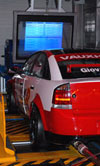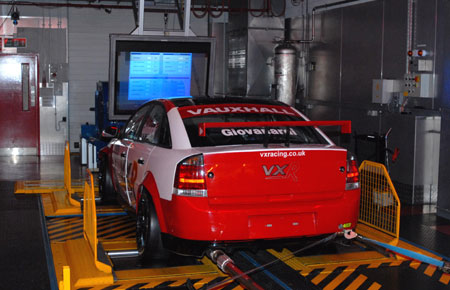Emission Testing in Motorsport
 Amid all the hype over the past few years of Global Warming or as it has been re-branded now, Climate Change, it won't surprise anyone that motorsport has come in for its own fair share of criticism. Viewed by some as a waste of resources, the sport is now fighting back and where once the word 'power' was king, 'efficiency' now replaces it. But from a motorsport perspective, 'efficiency' can mean many different things but in the final analysis and in today's world it all comes down to one thing - fuel consumption or as the politicians would now like us to refer to it as - carbon dioxide (CO2).
Amid all the hype over the past few years of Global Warming or as it has been re-branded now, Climate Change, it won't surprise anyone that motorsport has come in for its own fair share of criticism. Viewed by some as a waste of resources, the sport is now fighting back and where once the word 'power' was king, 'efficiency' now replaces it. But from a motorsport perspective, 'efficiency' can mean many different things but in the final analysis and in today's world it all comes down to one thing - fuel consumption or as the politicians would now like us to refer to it as - carbon dioxide (CO2).
Last year (2009), the organisers of the British Touring Car Championship made great play over the emissions testing of all their competing cars. Monitoring only carbon dioxide emissions (and dutifully simply ignoring all of the real toxics coming out of the exhaust) and using one of the best emission test facilities in the UK, the programme concluded that while racing cars could be made to be as 'efficient' as road cars, running a test cycle that both could achieve sensibly, the EU CO2 emissions target for the immediate future of 120 gm/km, simply does not equate with a racing car (or indeed a road car) doing 10 - 15 miles per gallon. Sadly, the real numbers of the work will never be published but in doing it, the BTCC have somehow inadvertently highlighted the real difficulties of measuring vehicle emissions, especially those from competition cars.
The idea behind any kind of emissions testing is to test the vehicle under the conditions in which it is most likely to be used. Thus for road going vehicles we have a mixture of urban and highway duty cycles covering speeds around and up to 50 km/h and 120 km/h respectively. Following a similar argument for race vehicles typical speeds would need to be anywhere between 110 km/h and say, 240 km/h. I don't know about you, but sitting in 150 mph racer is scary enough but strapping that onto a dynamometer and repeating it within the confines of a vehicle test cell is perhaps more than the nerves may be able to take. And don't forget, front wheel drive vehicles are fundamentally unstable on chassis rollers and so any testing of this type would require the vehicle to be well and truly tied down!

Competition engines also tend to be highly dynamic. Rapid changing of engine speeds and loads would need a dyno not just capable of absorbing the 300 bhp of a modern BTCC car, but also the capability of controlling those loads to the required accuracy. The only vehicle dynamometer with very low inertia, fast response and the ability to absorb power as well as motor the vehicle, (to simulate the incidence of heavy braking when the inertia of the vehicle reacts against the engine) is an AC unit. Each vehicle would still have to undertake 'coast-down' testing to replicate frictional losses and a suitable drag coefficient determined to simulate the aerodynamic forces. All in all quite a lot of what I would call unnecessary effort to achieve what would appear to be very little. Of course, we could transfer all of this to a transient engine test bed, a là that found with Formula One engine manufacturers, but that's getting a little out of hand, isn't it?
Undertaking a test cycle simulating a race vehicle running between 110 km/h and 130 km/h swapping between 5th and 6th gears was therefore hardly representative but the BTCC, I suppose, did produce the opportunity to compare results with their OE counterparts. No, the only sensible way of measuring any emissions on a race car would be to do it on track with some kind of mobile sensor or analyser. While I hear that one emissions analyser company may be interested in picking up the gauntlet again to develop an on-board emissions measuring system, wouldn't it be easier simply to measure the fuel consumption and, since the amount of carbon in any fuel can be accurately established, calculate back?
Fig. 1 - On the Rollers
Written by John Coxon